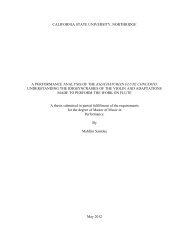2644 - CSUN ScholarWorks - California State University, Northridge
2644 - CSUN ScholarWorks - California State University, Northridge
2644 - CSUN ScholarWorks - California State University, Northridge
Create successful ePaper yourself
Turn your PDF publications into a flip-book with our unique Google optimized e-Paper software.
50 · Journal of Student Research Abstracts<br />
2748<br />
THE EFFECT OF CAFFEINE ON THE REGENERATION RATE OF PLANARIA<br />
Dana Pong and Stephen DeGusta (teacher). John F. Kennedy High School, 6715 Gloria Dr., Sacramento,<br />
CA 95831.<br />
Caffeine is a stimulant that when taken in large doses leads to health complications. Doses over a certain<br />
amount lose stimulant effects and take on depressant effects. Because it affects primarily the brain, the control<br />
of all bodily functions, caffeine has a potential influence on growth. In this study I investigated the question,<br />
"Does caffeine slow the regeneration rate of planaria?" My hypothesis was that if caffeine slows the regeneration<br />
rate of planaria, then the experimental group will regenerate at a rate significantly slower than that of the<br />
control group. Planaria were chosen as the subjects for study because of their notable ability to regenerate lost<br />
parts. For my experiment twenty planaria were used-10 control and 10 experimental. Each planarian was<br />
measured using a half millimeter ruler before its head was dissevered. The control was exposed to dechlorinated<br />
tap water, and the experimental to Water Joe caffeinated water (3mg/25ml). The growth was observed by<br />
daily measurement over a period of ten days. Along with the measurement, the day, date, and time of the measurement<br />
were recorded. After the regeneration rates were calculated [(total amount of growth)/(number of<br />
days)], it was determined that the control group regenerated faster than the experimental group. Results of the<br />
t-Test yielded a p value less than 0.1, indicating that the results were significant in proving that caffeine does<br />
slow the regeneration rate of planaria.<br />
2749<br />
EFFECTS OF COMMERCIAL SOLUTIONS ON BACTERIAL GROWTH.<br />
L.R. Pool, A.P. Varela, L.M. O'Neill, DX Santoso and B. VanDuzee (teacher). Saugus High School, 21900<br />
W. Centurion Way, Saugus, CA 91350.<br />
This experiment examined the effectiveness of household antibacterial products in inhibiting the growth of<br />
bacteria. In the experiment, performed three times, petri dishes were prepared with agar solution. After the agar<br />
congealed, it was scraped with a copper wire so bacterial could permeate the agar. Then seven indicator disks<br />
were each soaked in one of the following solutions: hand soap, kitchen cleaner, all purpose cleaner, shampoo,<br />
anti-bacterial hand gel, dish washing soap, and medical disinfectant (Neosporin). The disks were placed in different<br />
petri dishes, along with one disk left clean for control factor purposes. After spending one week in at<br />
room temperature, 70 degrees, bacteria had developed on the agar. The control sample clearly had developed<br />
the most bacteria, and had no visible ring of inhibition. The ring of inhibition is the area around the disks where<br />
the bacteria didn't grow because of the antibacterial product. Therefore, the larger the ring of inhibition, the<br />
more antibacterial potency the products contains. The shampoo, hand soap, kitchen cleaner, dish washing soap,<br />
and all purpose cleaner all had small rings of inhibition with significant amounts of bacteria not far from the<br />
disk. The average diameter of the rings from the three trials, including the diameter of the disk which was 0.4<br />
centimeters (em), were as follows: 1 em for the hand soap, 1.2 em for the kitchen cleaner, 1.25 em for the all<br />
purpose cleaner, 0.8 em for the shampoo, and for dish washing soap 1.15 em. The anti-bacterial hand gel and<br />
the medicinal disinfectant had relatively large rings of inhibition in relation to the other disinfectants. The average<br />
rings of inhibition were as follows: 2.4 em for the anti-bacterial hand gel and 2.9 em for the Neosporin.<br />
These results show that using commercial solutions does inhibit the growth of bacteria, and anti-bacterial hand<br />
gel and medicinal disinfectant are the most effective in blocking this growth.













